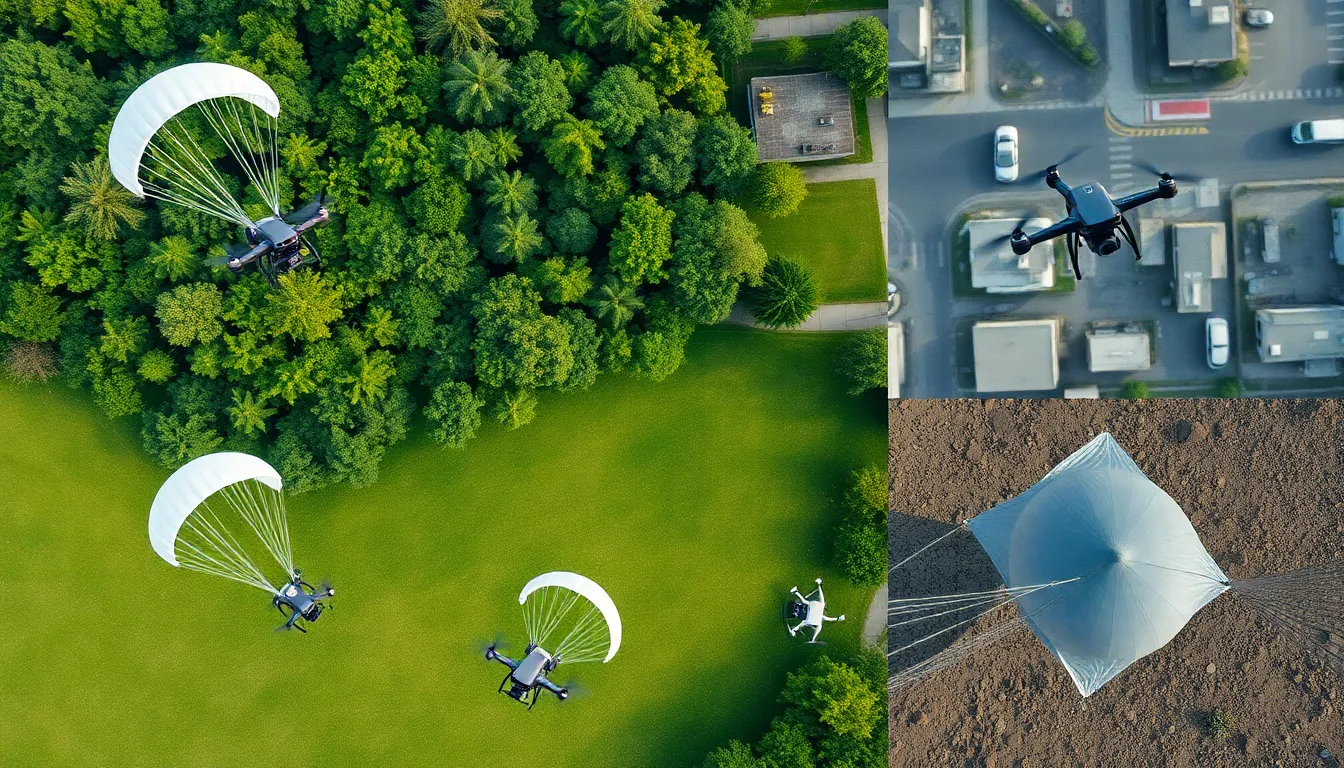Drones are the superheroes of the skies, zipping around delivering packages and capturing breathtaking footage. But what happens when these high-flying gadgets face an unexpected crash landing? Enter drone recovery systems, the unsung heroes that ensure these flying machines don’t meet their demise in a spectacular fashion.
Table of Contents
ToggleOverview of Drone Recovery Systems
Drone recovery systems ensure safe operation by preventing crashes and enabling emergency landings. Various technologies contribute to these systems. For instance, parachute systems deploy when a drone faces critical failure, allowing a soft descent to the ground.
Another technology involves net capture systems that can intercept drones mid-air. These systems often use a net to ensnare the drone, safely bringing it down without damage. Additionally, crash prevention software utilizes sensors and algorithms to assess flight paths, automatically altering them to avoid obstacles.
Smart recovery systems integrate GPS and telemetry data. These systems track drone position and altitude, guiding it back to the designated landing zone when necessitated. Moreover, fail-safe mechanisms activate when drones experience low battery levels, steering them to predetermined locations.
Compliance with regulations influences the need for reliable recovery systems. Many regions require drones to have fail-safe features to operate legally. Various manufacturers design recovery systems tailored to specific models.
Implementation of recovery systems significantly impacts the drone’s operational capabilities. For commercial applications, having a robust recovery system enhances safety and reliability. Ultimately, drone recovery systems contribute to the advancement of aviation technology, ensuring safer skies for both operators and the public.
Types of Drone Recovery Systems

Various types of drone recovery systems exist, each designed to enhance safety during flight operations. Understanding these systems helps operators choose the best option for their specific needs.
Parachute Recovery Systems
Parachute recovery systems deploy a simplified parachute when a drone experiences critical failures. This type of system allows drones to descend gently, minimizing damage upon landing. It relies on a triggering mechanism that activates automatically based on altitude or flight status. Numerous manufacturers offer these systems tailored to different drone models, ensuring compatibility and efficiency. Studies show that parachute systems can reduce impact forces by up to 80%, significantly enhancing safety during emergencies.
Net Recovery Systems
Net recovery systems capture drones mid-air using a net designed to trap them upon descent. These systems often involve a network of large nets set up at designated landing or monitoring areas. Operators can deploy these nets automatically when necessary. Effectiveness increases with proper placement and height, making these systems ideal in urban environments or crowded areas. Implementation of net systems can drastically improve recovery outcomes, minimizing risks to both the drone and people nearby.
Airbag Recovery Systems
Airbag recovery systems inflate upon drone impact, providing cushioning during landings. This method uses sensors to detect imminent crashes, activating airbags to absorb shock energy. Performance can vary based on drone weight and speed, necessitating precise adjustments for optimal effectiveness. Many drone manufacturers develop airbag systems to meet specific operational requirements. Operators find these systems particularly useful in rugged terrain or scenarios where terrain challenges may lead to hard landings.
Key Features of Effective Recovery Systems
Effective drone recovery systems prioritize reliability and safety, ensuring optimal performance under various conditions. The implementation of proven technologies plays a crucial role in enhancing these aspects.
Reliability and Safety
Reliability often depends on consistent performance during critical scenarios. Parachute recovery systems have shown the ability to reduce impact forces by up to 80% during failures. Each system integrates advanced sensors that trigger deployment when necessary, significantly improving safety outcomes. Additionally, net capture systems function effectively in urban environments, providing a dependable method to intercept drones mid-air. Investing in robust recovery systems reinforces the overall safety profile of drone operations, paving the way for broader acceptance and regulatory compliance.
Cost-Effectiveness
Cost-effectiveness emerges as a key consideration for many operators. While initial investments in recovery systems can vary, long-term savings become apparent through reduced crash-related expenses. Utilizing airbag recovery systems cushions landings and minimizes damage, ultimately lowering repair costs. Moreover, efficient recovery technologies can lead to fewer accidents, translating into lower insurance premiums. As drone usage continues to expand in commercial sectors, the financial benefits of implementing effective recovery systems become increasingly evident, fostering safer operations and enhancing overall value.
Applications of Drone Recovery Systems
Drone recovery systems play a crucial role across various fields. Their applications range from emergency services to commercial delivery, demonstrating versatility and reliability.
Search and Rescue Missions
Drone recovery systems enhance the effectiveness of search and rescue missions. In challenging environments, these systems ensure that drones can return safely, even during adverse conditions. For example, parachute systems provide controlled descents, reducing risk of damage and enabling continuous aerial support. Teams can deploy drones equipped with recovery technology to survey remote areas swiftly, minimizing downtime. The ability to safely recover drones encourages more comprehensive coverage and increases the likelihood of locating missing persons or assets.
Delivery Services
Drone recovery systems revolutionize delivery services in urban and rural settings alike. A reliable recovery mechanism ensures drones can safely operate, reducing the chances of accidents during transit. Net capture systems effectively mitigate risks when drones encounter unexpected obstacles, allowing for safe retrieval and minimal disruption. With crash prevention technologies in place, service providers can maintain efficiency while ensuring packages reach their destinations intact. This focus on safety boosts consumer confidence, making drone delivery a more attractive option for businesses and customers.
Future Trends in Drone Recovery Technology
Emerging innovations are reshaping drone recovery technology, focusing on enhanced safety and functionality. Advanced parachute systems are being developed, offering quicker deployment times and lighter materials. Next-generation net systems are incorporating smart features that allow for adaptive intercept strategies in complex environments.
Improved sensors play a pivotal role in these advancements. Companies are integrating cutting-edge obstacle detection systems capable of identifying and responding to various challenges in real time. Enhanced algorithms will enable drones to better assess landing conditions, ensuring safer recovery in diverse scenarios.
In addition, increased integration of artificial intelligence is expected. AI will facilitate predictive recovery measures based on flight patterns, making it easier to anticipate and react to potential failures. Manufacturers are designing systems that can analyze previous flight data to optimize recovery strategies for future missions.
Battery management technology is set to advance as well. Recovery systems will feature more sophisticated fail-safe protocols that activate not just during low battery situations but also in adverse weather or other critical conditions. Such features provide greater reliability in emergency scenarios.
The regulatory landscape is also evolving. As drone usage grows, regulatory bodies are likely to mandate enhanced recovery standards, pushing manufacturers to innovate continuously. Compliance with these standards ensures that recovery systems remain effective and trustworthy.
Finally, sustainability will gain prominence in the development of recovery systems. Eco-friendly materials are being explored to minimize the environmental impact of drone operations. Companies are increasingly looking for ways to balance performance requirements with ecological responsibilities.
Drone recovery systems are essential for ensuring safe and reliable operations in an increasingly drone-dependent world. With advancements in technology and a focus on safety these systems not only protect the drones but also enhance overall operational efficiency. As industries continue to adopt drone technology the importance of effective recovery mechanisms will only grow.
Investing in robust recovery systems proves beneficial not just for safety but also for long-term cost savings. As innovations emerge manufacturers will need to stay ahead of the curve to meet evolving regulatory standards and consumer expectations. The future of drone operations looks promising as these systems evolve to provide even greater safety and reliability.









